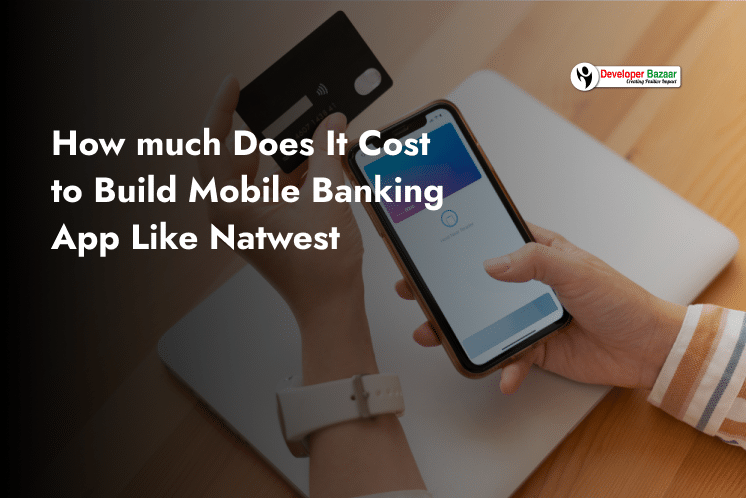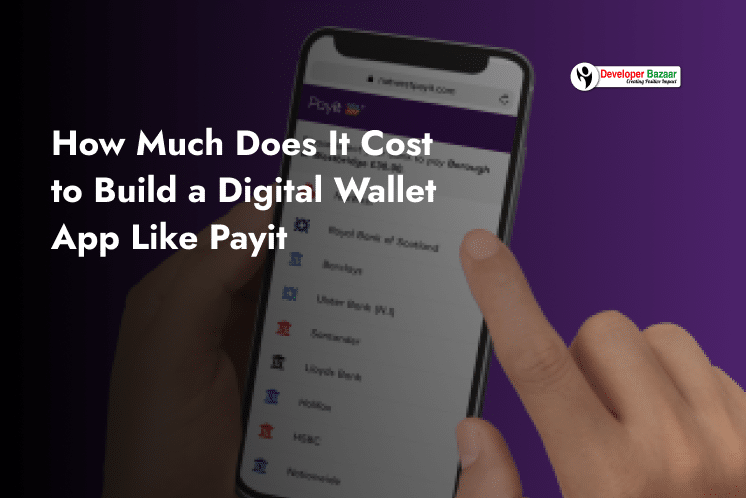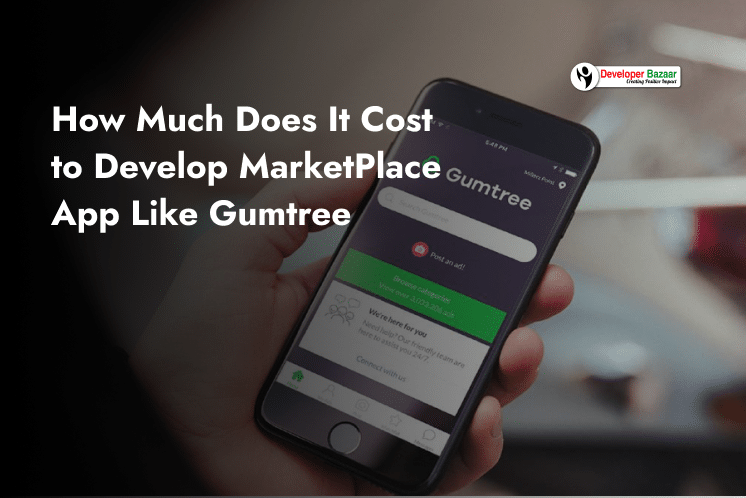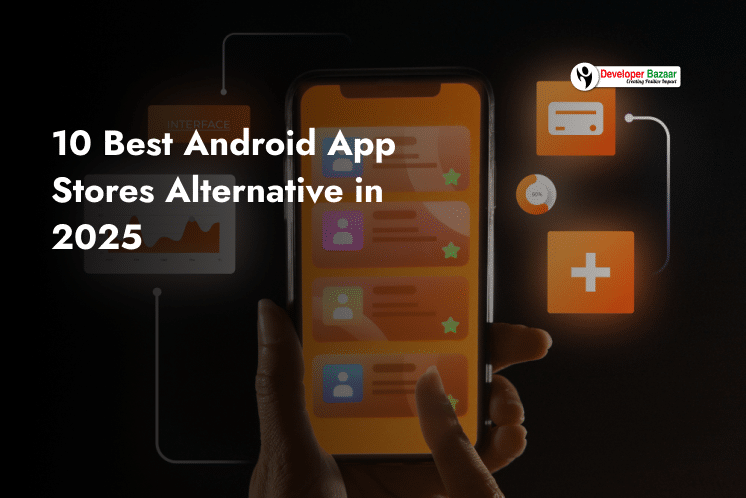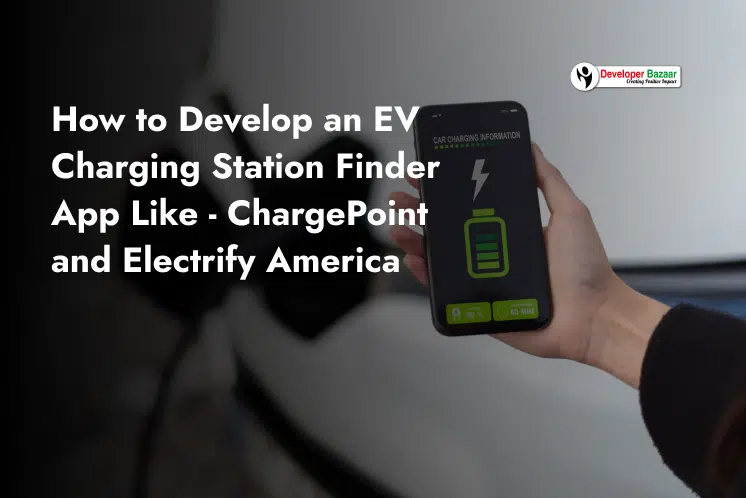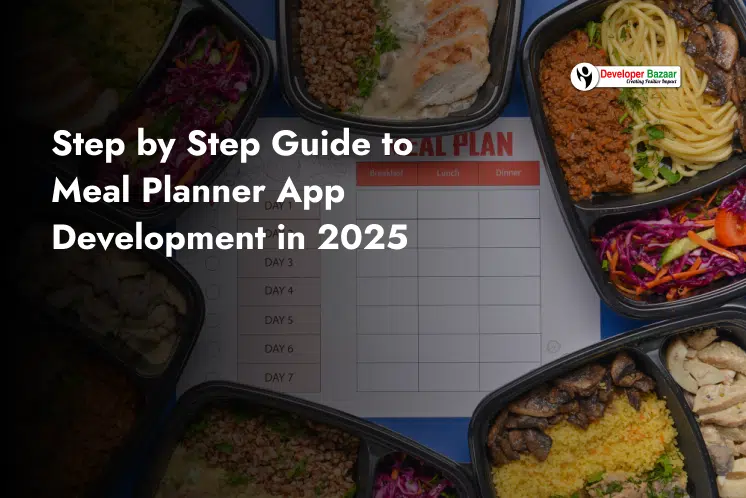Table of Contents
ToggleEver had a flat tire in the middle of nowhere or a dead battery when you’re running late?
In such a scenario roadside assistance apps come to assist you. These mobile applications provide instant access to towing, fuel delivery, and emergency repairs, ring drivers get back on the road quickly.
As the demand for roadside assistance grows, businesses are increasingly investing in roadside assistance app development to offer reliable and efficient services.
This guide explores the process, key statistics, and cost factors involved in building a roadside assistance mobile app.
Overview of Roadside Assistance App Development
The roadside ways can be unpredictable, flat tires, engine failures, or lockouts can happen at any time. A roadside assistance mobile app acts as a digital lifeline, connecting stranded drivers with service providers in real time.
The industry is gaining popularity, due to the rise in vehicle usage and the need for instant support. Whether it’s for individual drivers or fleet management, businesses are recognizing the value of developing a towing roadside assistance mobile application.
These apps typically include features like GPS tracking, emergency alerts, and digital payments to enhance user experience. With rapid technological advancements, AI-powered chatbots and predictive analytics are being integrated to make the process even more seamless.
However, before diving into development, understanding the roadside assistance app development cost and market trends is crucial.
Roadside Assistance Mobile App: Key Statistics
Here are mentioned key statistics that bring you to learn how the roadside assistance market is rapidly growing. According to Fortune Business Insights,
- The global roadside assistance market is expected to grow from $24.34 billion in 2023 to $35.73 billion by 2030.
- Europe leads in roadside assistance subscriptions, holding the largest market share.
- On average, a roadside assistance mobile app ensures help arrives within 30 minutes.
- User satisfaction is high, with over 60% of Google Play Store reviewers rating these apps positively.
With the increasing reliance on mobile solutions, investing in roadside assistance app development is a strategic move for businesses aiming to provide efficient and timely services.
How Does a Roadside Assistance App Work?
Ever found yourself stranded on the road with a dead battery or a flat tire? A roadside assistance app can be a lifesaver in such situations. These apps connect drivers with nearby service providers to get instant help.
Here’s how it works:
- Users sign up on the app and create their profiles. When they need help, they select the required service, jump-start, tire change, fuel delivery, or towing and share their location.
- The app automatically finds the nearest available service provider and sends a request. Once a provider accepts, they navigate to the user’s location.
- Users can track the service provider’s real-time location and estimated arrival time. Once the service is complete, payments are securely processed within the app.
- With 24/7 availability, transparent pricing, and fast response times, a well-developed towing roadside assistance mobile application offers drivers peace of mind and convenience.
How to Develop a Roadside Assistance App?
Developing a successful roadside assistance app requires proper planning and execution. Follow these key steps:
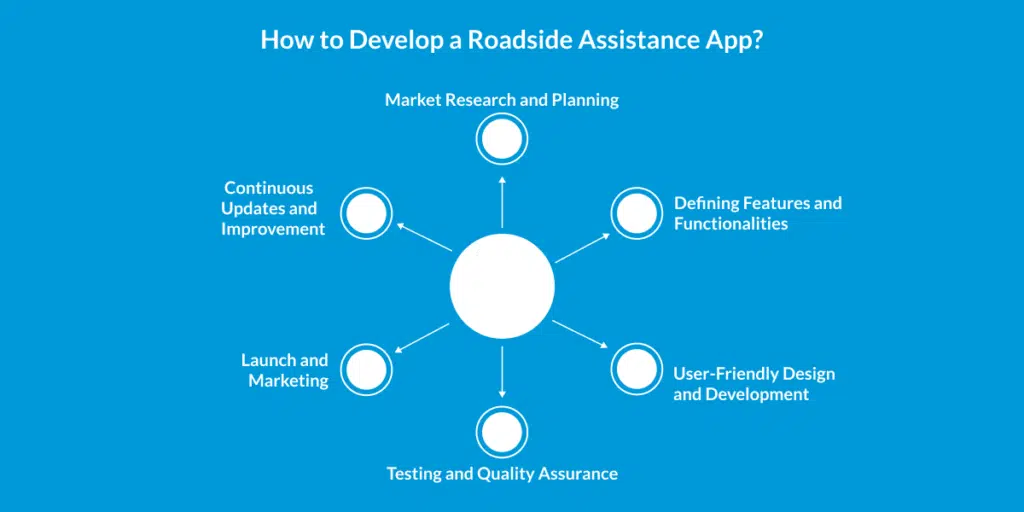
1. Market Research and Planning
Before you start, understand your target users. Identify their common roadside problems and how they seek help. Study existing apps in the market. Analyze their strengths and weaknesses. Find gaps that your app can fill to stand out.
2. Defining Features and Functionalities
A smooth user experience is essential. Your app should have:
- Easy registration and login for both users and service providers.
- Clear service options like towing, jump-start, tire change, and fuel delivery.
- Real-time location tracking to ensure quick response times.
- Secure payment options for a hassle-free experience.
- A system to manage service providers and ensure quality service.
A well-structured roadside assistance app development plan will help in delivering the best features.
3. User-Friendly Design and Development
A simple and intuitive interface makes an app easy to use. Choose the right development approach, native or cross-platform, based on your budget and audience. Work with an experienced roadside assistance app development company to build a high-performing app.
4. Testing and Quality Assurance
Before launching, test the app in real-world situations. Ensure smooth functionality, fix any bugs, and optimize speed. A well-tested app ensures a better user experience and trust.
5. Launch and Marketing
Optimize your app for the app store using keywords like roadside assistance app development to improve visibility. Promote the app through SEO, social media, and digital advertising. Partner with auto service businesses to attract users.
6. Continuous Updates and Improvement
Monitor user feedback to understand what’s working and what needs improvement. Regular updates with new features will keep the app competitive. Track performance metrics and fix issues quickly to make sure to simplify the operations.
With the right mobile app development company, you can build a powerful and reliable roadside assistance app that meets user needs and ensures business growth.
Must-have Features of Vehicle Roadside App
A roadside assistance app helps drivers get quick help when their vehicle breaks down. It connects users with service providers like tow trucks, mechanics, or fuel delivery services.
If you’re planning to build a roadside assistance mobile app, it’s essential to focus on user-friendly features, the right business model, and the best technology.
To make your app useful and efficient, it should include key features that improve the user experience.
Below are some key features mentioned:
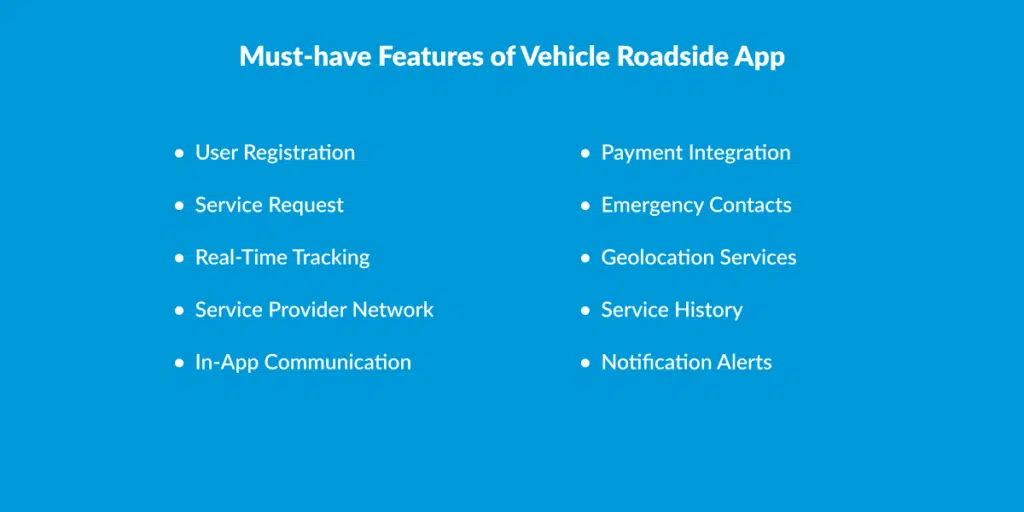
1. User Registration
Users should be able to create an account easily using their email, phone number, or social media. A registered account allows them to save personal details, track past service requests, and make future bookings faster.
2. Service Request
The app should allow users to request different roadside assistance services. They should be able to choose from options like towing, jump-start, tire replacement, or fuel delivery. The service request process should be simple, with just a few taps.
3. Real-Time Tracking
Once a user requests assistance, they should be able to track the service provider’s location in real-time. This helps them see the estimated arrival time and plan accordingly. It also adds transparency and improves trust in the service.
4. Service Provider Network
The app should have a strong network of service providers, including towing companies, mechanics, and fuel delivery services. A reliable network ensures that users get quick help, no matter what the circumstances are.
5. In-App Communication
Users and service providers should be able to communicate directly through the app. A chat or call option can help users explain their issue better and get updates from the service provider. This feature ensures clear and quick communication.
6. Payment Integration
The app should have secure and convenient payment options. Users should be able to pay using credit/debit cards, mobile wallets, or UPI. A mobile app development company can integrate safe payment gateways like PayPal or Stripe.
7. Emergency Contacts
Users should be able to save emergency contact numbers within the app. In case of an accident or serious breakdown, they can quickly call for additional help.
8. Geolocation Services
GPS tracking is essential for an on-demand roadside assistance app. The app should detect the user’s exact location and send it to the nearest available service provider for faster assistance.
9. Service History
Users should be able to view a record of all their past service requests. This helps them track expenses and check the details of previous roadside assistance. Service providers can also use this feature to manage their jobs efficiently.
10. Notification Alerts
Push notifications are useful for keeping users updated. They should receive alerts about service provider arrival time, updates on their request, and promotional offers. Notifications improve engagement and user experience.
A well-designed roadside assistance app development strategy includes these essential features to ensure a smooth and efficient service.
How Much Cost Does It Take to Build a Roadside Assistance App?
The cost to build a roadside assistance mobile app varies depending on several factors. The estimated cost typically ranges from $30,000 to $150,000.
However, the final app development cost depends on complexity, platform, features, location, and team expertise.
Below is a breakdown of the key cost factors:
| Factors | Cost Estimate |
|---|---|
| App Complexity | |
| Basic (Login, Profile, Dashboard) | $20,000 – $50,000 |
| Medium (Payments, Social Login, Security) | $50,000 – $120,000 |
| Advanced (AI, ML, AR/VR Features) | $120,000 – $150,000+ |
| Development Team Expertise | |
| Junior Developers | $50 – $100 per hour |
| Mid-Level Developers | $100 – $150 per hour |
| Senior Developers | $150 – $250+ per hour |
| Feature Integration | |
| Custom Features | $4,500 |
| Third-Party API Integration | $8,000 |
| Complex Features (AI, ML, Automation) | $12,000 |
| Platform Selection | |
| Native Apps (Android & iOS) | $50,000 – $100,000 |
| Cross-Platform Apps | $25,000 – $60,000 |
| Web-Based App | $15,000 – $50,000 |
| Hybrid Apps | $10,000 – $150,000 |
The cost of roadside assistance app development depends on your business goals, the features you choose, and the development team you hire. Working with an experienced mobile app development company ensures a high-quality app that meets industry standards.
Factors Affecting the Cost of Roadside Assistance App Development
The app development cost for a roadside assistance app depends on multiple factors.
Understanding these factors can help you plan your budget effectively.
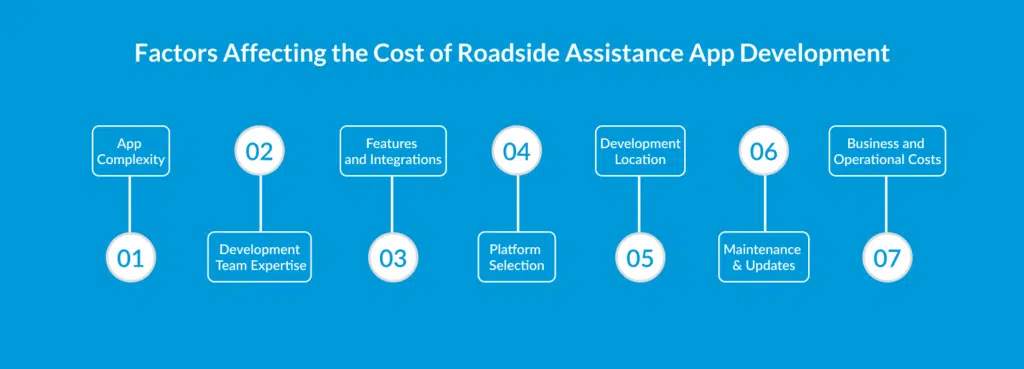
1. App Complexity
The cost will be higher according to the app complexity. A basic app includes features like login, user profiles, and a dashboard, making it the most affordable option.
A medium-complexity app comes with additional functionalities like payment integration, social login, and real-time tracking, increasing the cost.
An advanced app integrates AI, machine learning, and AR/VR technologies for smart assistance, making it the most expensive to develop.
2. Development Team Expertise
Hiring an experienced mobile app development company or skilled developers also impacts the cost. Junior developers charge lower rates but may take longer to complete the app.
Mid-level developers have more experience and can deliver better results at a moderate price. Senior developers charge the highest rates but provide top-quality development, and build an efficient app.
3. Features and Integrations
The number and complexity of features directly affect the cost. A basic app will include essential features like registration, service selection, and a user dashboard.
Integrating third-party APIs, such as Google Maps, payment gateways, and push notifications, will increase costs. Adding advanced features like AI-powered assistance, chatbots, and predictive analytics will further raise the budget.
4. Platform Selection
The platform you choose significantly affects the cost. Native apps for iOS and Android offer the best performance but are more expensive to develop.
Cross-platform apps are more budget-friendly, but they may have performance limitations. Web-based apps are the cheapest to develop, but they offer limited functionality compared to mobile apps.
5. Development Location
The geographical location of your development team affects hourly rates. Developers in the USA and Western Europe charge the highest rates, making development expensive.
Eastern Europe and the UAE offer moderate pricing, balancing cost and quality. Asia and India have the most cost-effective development rates, making them an ideal choice for budget-conscious businesses.
6. Maintenance & Updates
The cost does not end after launching the app. Ongoing maintenance includes server hosting, security updates, bug fixes, and feature upgrades.
Regular updates are necessary to keep the app running smoothly. Additionally, app store fees and compliance updates add to the total cost.
7. Business and Operational Costs
Beyond app development, there are business costs to consider. Licensing and legal permits are essential to operate the service legally. Insurance is required to protect the business from liabilities. Employee salaries, marketing, and advertising campaigns also contribute to the overall investment.
By understanding these factors, you can better estimate the cost to build a roadside assistance mobile app and make informed financial decisions.
Why Invest in a Roadside Assistance App Development in 2025?
The demand for towing and roadside assistance services is increasing day by day. Developing a roadside assistance or towing app can be a profitable opportunity.
There are following reasons why you should invest in a roadside assistance app development:
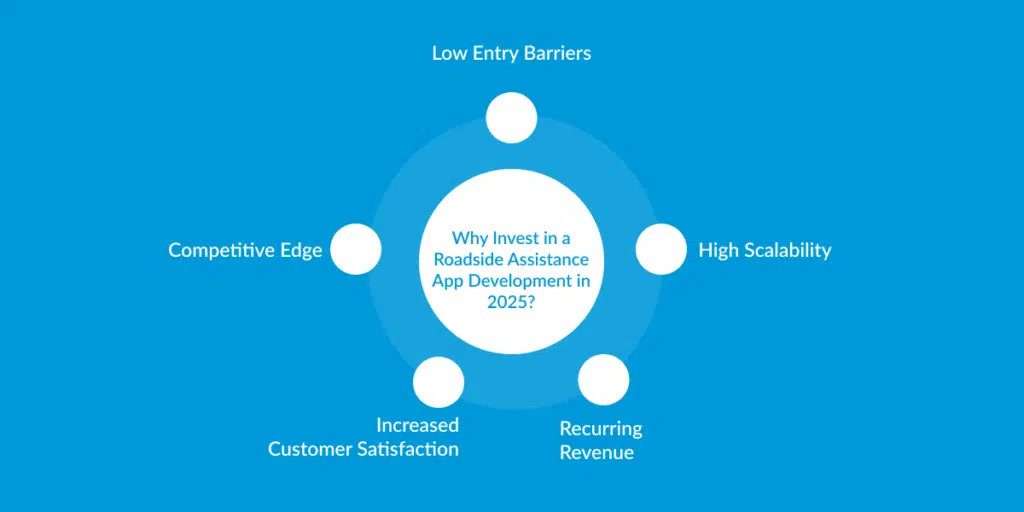
1. Low Entry Barriers
Unlike traditional businesses, a roadside assistance app does not require a physical office or vehicle fleet. All you need is a well-built app and a network of service providers.
2. High Scalability
A mobile app development company can develop an app that starts locally and expands nationally. A single dashboard allows you to manage everything efficiently as demand grows.
3. Recurring Revenue
Subscription models, premium features, and in-app advertising can generate steady income. Loyalty programs and targeted promotions help retain customers and drive repeat business.
4. Increased Customer Satisfaction
With real-time tracking, instant support, and secure payment options, a roadside assistance towing app ensures a better user experience. Happy customers mean higher retention rates.
5. Competitive Edge
As more drivers rely on mobile solutions, investing in roadside assistance app development can position your business as a leader in the industry.
By partnering with an experienced mobile app development company, you can create a feature-rich and scalable app that meets user needs while ensuring long-term growth.
Business Models for Towing/Road Assistance App
To make a roadside assistance or towing app development project successful, choosing the right business model is crucial.
Below are the three common business models:
1. Roadside Assistance Center
This model works like a dedicated roadside assistance company. The business owns and manages its own fleet of tow trucks and mechanics.
Users can request help directly from the company, ensuring quick and efficient service. The app helps manage staff, bookings, payments, and dispatching through a dashboard.
2. Single-Service Aggregator
In this model, the app focuses on a single type of roadside assistance service, such as towing or tire replacement.
It works similarly to Uber for towing, where users request a service, and the app connects them with the nearest available provider. This model is suitable for businesses specializing in one service.
3. Multi-Service Aggregator
This model allows users to access multiple services from different providers. Users can choose from various service providers based on pricing, reviews, and availability.
This approach gives users more choices and flexibility, making it a popular business model for roadside assistance app development companies.
Technology Stack for Roadside Assistance App Development
Choosing the right technology stack is crucial for a roadside assistance app development company to build a reliable and scalable app.
There are following the best technologies to consider:
1. Mobile Development
2. Backend Development
A strong backend ensures smooth app performance. Node.js is great for real-time applications, while Python (Django/Flask) and Ruby on Rails are excellent for scalable development.
3. Database
For structured data storage, MySQL and PostgreSQL are reliable choices. If you need flexibility, MongoDB is a good NoSQL database option.
4. Cloud Hosting
AWS, Google Cloud, and Azure provide secure and scalable hosting solutions. These cloud services ensure smooth app operations, even with high traffic.
5. Mapping and Location Services
Google Maps and Mapbox help in providing accurate GPS tracking, navigation, and geolocation services. These are crucial for dispatching service providers efficiently.
6. Payment Gateway Integration
For secure transactions, integrating payment gateways like Stripe, PayPal, or Braintree ensures smooth and safe payments.
7. Real-Time Communication
To enable instant messaging and updates between users and service providers, WebSockets and Socket.IO are the best solutions. These technologies allow real-time communication within the app.
With the right technology stack and a reliable mobile app development company, you can build a powerful roadside assistance app that ensures fast and efficient service for users.
How to Make Money from a Roadside Assistance App?
Developing a towing roadside assistance mobile application requires investment. However, there are many ways to generate revenue from it.
Here are the top monetization strategies:
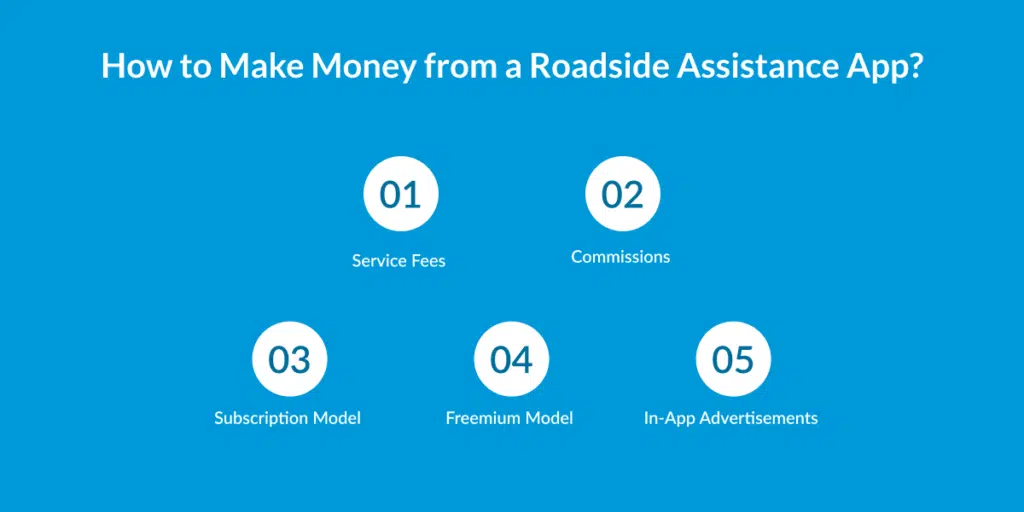
1. Service Fees
Users pay a fee for the roadside assistance service they request. The app can charge based on the type of service and the distance traveled by the service provider. Offering different pricing tiers can make the service more flexible for users.
2. Commissions
Instead of charging users directly, the app can take a commission from service providers. Every time a provider gets a booking through the app, they pay a percentage of the earnings to the platform. This helps generate consistent revenue without increasing the cost for users.
3. Subscription Model
Users can pay a monthly or yearly subscription fee for benefits like priority assistance, discounted services, or free service calls up to a certain limit. Subscription plans help in generating steady income while offering value to frequent users.
4. Freemium Model
Basic roadside assistance services can be free, while advanced features like faster response times, premium customer support, or roadside insurance coverage can be paid. This model attracts users while offering paid add-ons for extra revenue.
5. In-App Advertisements
The app can display ads from auto repair shops, car insurance companies, and fuel stations. By showing targeted ads based on user location and needs, the app can earn from businesses that want to promote their services.
A well-planned roadside assistance app development cost can be recovered using these revenue models.
Choose the Right Mobile App Development Company
Selecting the right mobile app development company is crucial for building a successful roadside assistance app. An experienced team ensures smooth performance, scalability, and user-friendly design.
Look for a company with a strong portfolio in roadside assistance app development. Check their past projects, client reviews, and expertise in on-demand service apps.
Make sure they offer end-to-end solutions, including design, development, testing, and post-launch support.
Communication is key. Choose a company that understands your vision and keeps you updated throughout the process. Discuss timelines, features, and app scalability before starting the project.
A reliable development partner will help you build a roadside assistance mobile app that meets user expectations and business goals.
Conclusion
A roadside assistance app provides quick and reliable help to stranded drivers. It enhances convenience, safety, and transparency in roadside services. With a well-planned approach and the right development team, you can launch a high-performing app that meets market demands.
Investing in roadside assistance app development can open new business opportunities. Focus on user experience, real-time tracking, and seamless payments to ensure long-term success. Stay ahead by continuously improving your app based on user feedback.
FAQs
1. How long does it take to build a roadside assistance mobile app?
A: The timeline depends on app complexity and features. A basic app may take 3 – 4 months, while an advanced version can take 6+ months.
2. How can I monetize my roadside assistance app?
A: You can earn through service fees, subscription plans, partnerships, and advertising within the app.
3. Can I scale my roadside assistance app to multiple cities?
A: Yes, with proper planning, you can expand your app to serve multiple locations and even operate nationwide.
4. What are the key challenges in roadside assistance app development?
A: Challenges include finding reliable service providers, ensuring real-time tracking accuracy, and integrating secure payment options.
5. How do I maintain my roadside assistance app after launch?
A: Regular updates, bug fixes, and performance monitoring are essential for smooth operations. Gather user feedback and improve the app accordingly.

RM Mishra
Co-Founder
Developer Bazaar technologies





